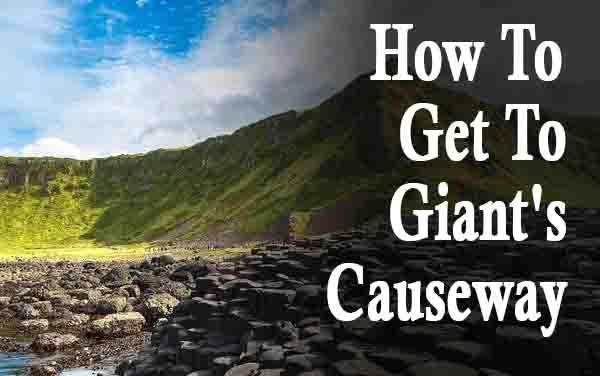If you’re planning a trip to the Giant’s Causeway, you’ll want to know where to go, how to get there, what to expect, and how to make the most of your time there. This post will help you find answers to all of these questions, as well as many more. It is an amazing natural wonder located in Northern Ireland. It’s a UNESCO World Heritage Site and one of the most famous tourist attractions in the world.
This post describes how to get to the Giant’s Causeway in Northern Ireland, a unique natural wonder that is one of the most popular tourist attractions in Europe.
Table of Contents
What is Giant’s Causeway
Giant’s Causeway is a large, spectacular, and unique rock formation on the coast of Northern Ireland.

It consists of approximately 100 huge columns of volcanic rock, which are known as “pillars” (a word derived from the Latin pila meaning ‘bamboo’) and form a natural arch, standing about 50 meters tall.
The tallest pillar, called “the Thistle,” rises to a height of 27 metres, while the second tallest, “the Pigeon,” reaches 19 metres.
Giant’s Causeway is one of the most visited natural attractions in Northern Ireland.
When to visit Giant’s Causeway
Giant’s Causeway National Park in Northern Ireland offers a spectacular natural wonderland and one of the most popular tourist attractions in Northern Ireland. The park is home to a large collection of over 80 million year old hexagonal volcanic columns known as the Giant’s Causeway, and is a major draw card for travellers.
Giant’s Causeway is located on the north coast of County Antrim, and is easily reached by public bus or train. The park has a variety of visitor facilities including a cafe, gift shop, visitor center, and many other activities for visitors to enjoy.
The park has two distinct visitor centers, one at the Giant’s Causeway Visitor Experience, and another at the Glendun Visitors Center. The Glendun Visitor Center is located at the entrance to the park and offers a full range of facilities for visitors. There are also numerous hiking trails to explore the area, and there is a small museum that focuses on the park’s geological history.
The Giant’s Causeway Visitor Experience provides a unique perspective of the causeway through a number of stunning exhibitions, including a display of local flora and fauna. One of the most interesting aspects of this attraction is the ‘Sea Monster’ exhibit where visitors can walk through an underwater tunnel to see a model of a giant sea creature, created by local sculptor Jim McWhirter.
The park is open all year round and offers a wide variety of activities for visitors to enjoy, including horse riding, golf, cycling, and walking. Many people visit the park on day trips from Dublin, Belfast, and Glasgow, as well as from across the world.
What to see and do in Giant’s Causeway
The most ancient history has been found in Ireland and the island of Ireland. The land of Ireland has been inhabited for thousands of years, the Stone Age, the Bronze Age, the Iron Age, the Viking age, the Medieval, and the modern era.
It has a history of its own and many things to offer. A history of natural and manmade wonders, a rich culture, and an interesting past.
Let us explore 10 reasons why you should visit the Giant’s Causeway.
The Natural Wonders
Giant’s Causeway is one of the most popular tourist attractions of Northern Ireland. The place is famous for the unique structure of its columns, it is formed by millions of large hexagonal stones, which are arranged in the shape of a giant’s head. The natural wonder attracts a huge number of tourists every year.
Ancient History
Giant’s Causeway is one of the oldest monuments on earth. According to the archaeologists, the first humans visited the place about 30,000 years ago.
Archaeological Remains
The Giant’s Causeway is also known as the ‘Jewel of Aran Island’ because of the vast array of archaeological remains that have been discovered here. It was the site of many battles between the Celts and the Romans.
Celtic Culture
The Giant’s Causeway is a place of Celtic culture. In fact, it is one of the oldest archaeological sites of Ireland. According to the researchers, it has a great impact on the development of Celtic civilization.
The Stone of Destiny
In the 6th century BC, the first Scottish king named Constantine I of Scotland brought the Stone of Destiny from the Holy Land and placed it in his capital.
It is the Birthplace of James II
It is the birthplace of James II, who is the last king of England. He was born in 1633 AD.
It is the Birthplace of King John
It is the birthplace of King John, the son of Henry II and Eleanor of Aquitaine.
It is the Birthplace of Queen Elizabeth I
It is the birthplace of Queen Elizabeth I, the daughter of Henry VII and Elizabeth of York.
It is the Birthplace of Charles II
It is the birthplace of Charles II, the son of Charles I and Henrietta Maria.
It is the Birthplace of St. Patrick
It is the birthplace of St. Patrick, the patron saint of Ireland.
Conclusion
In conclusion, I think that there are a lot of people who are interested in visiting the Giant’s Causeway, and there are a lot of different ways that you can go about doing so. For example, if you want to take a tour, you can do so on one of the tours that are available to you. Or, if you want to visit the park in the evening, you can do so by booking a stay at a hotel. And, if you want to visit the park without a tour, you can do so by booking a stay at a B&B.
